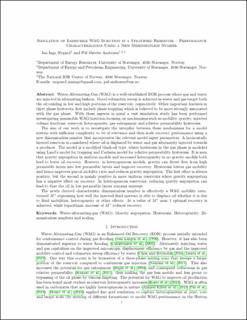| dc.description.abstract | Water alternating gas (WAG) is a well‐established enhanced‐oil‐recovery process where gas and water are injected in alternating fashion. Good volumetric sweep is achieved as water and gas target both the oil residing in low and high portions of the reservoir, respectively. Other important features in three‐phase hysteretic flow include phase trapping, which is believed to be more strongly associated with the gas phase. With these aspects in mind, a vast simulation study has been performed investigating immiscible WAG injection focusing on mechanisms such as mobility, gravity, injected volume fractions, reservoir heterogeneity, gas entrapment, and relative permeability hysteresis.
The aim of our work is to investigate the interplay between these mechanisms for a model system with sufficient complexity to be of relevance and then scale recovery performance using a new dimensionless number that incorporates the relevant model input parameters. A horizontally layered reservoir is considered where oil is displaced by water and gas alternately injected toward a producer. The model is a modified black‐oil type, where hysteresis in the gas phase is modeled using the Land (1968) model for trapping and the Carlson (1981) model for relative permeability hysteresis. It is seen that gravity segregation in uniform models and increased heterogeneity in no‐gravity models both lead to lower oil recovery. However, in heterogeneous models, gravity can divert flow from high‐permeability layers into low‐permeability layers and improve recovery. Hysteresis lowers gas mobility and hence improves gas/oil mobility ratio and reduces gravity segregation. The first effect is always positive, but the second is mainly positive in more uniform reservoirs where gravity segregation has a negative effect on recovery. In heterogeneous reservoirs, reducing gravity segregation can lead to the oil in low‐permeability layers remaining unswept.
The newly derived characteristic dimensionless number is effectively a WAG mobility ratio, termed M*, expressing how well the injected‐fluid mixture is able to displace oil, whether it is because of fluid mobilities, heterogeneity, or other effects. At a value of M* near unity, optimal recovery is achieved, whereas logarithmic increase of M* reduces recovery. | en_US |
